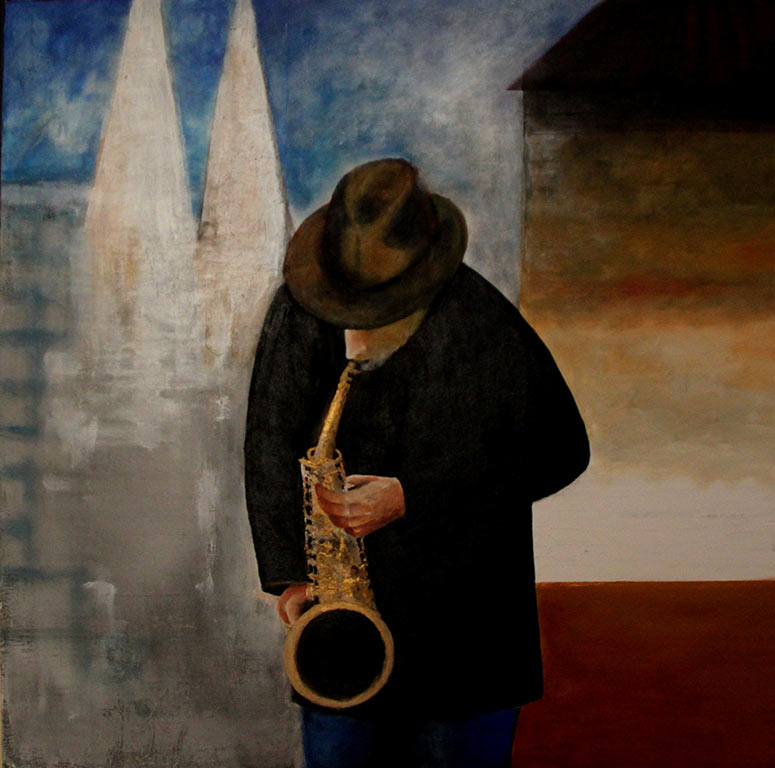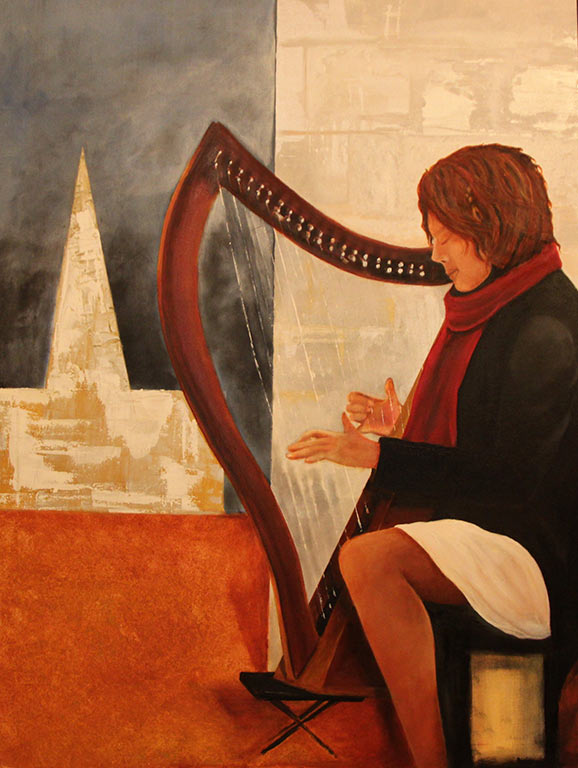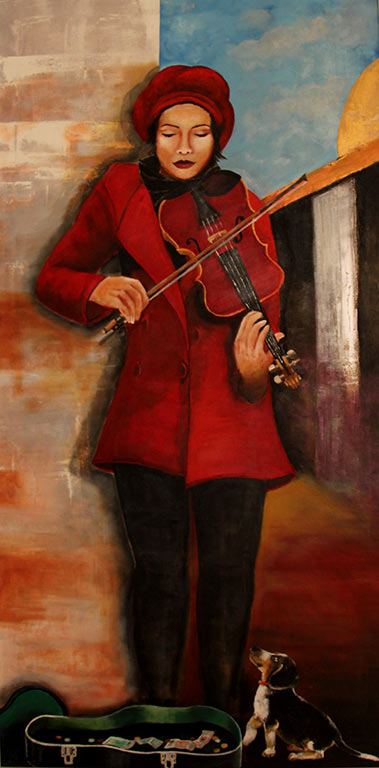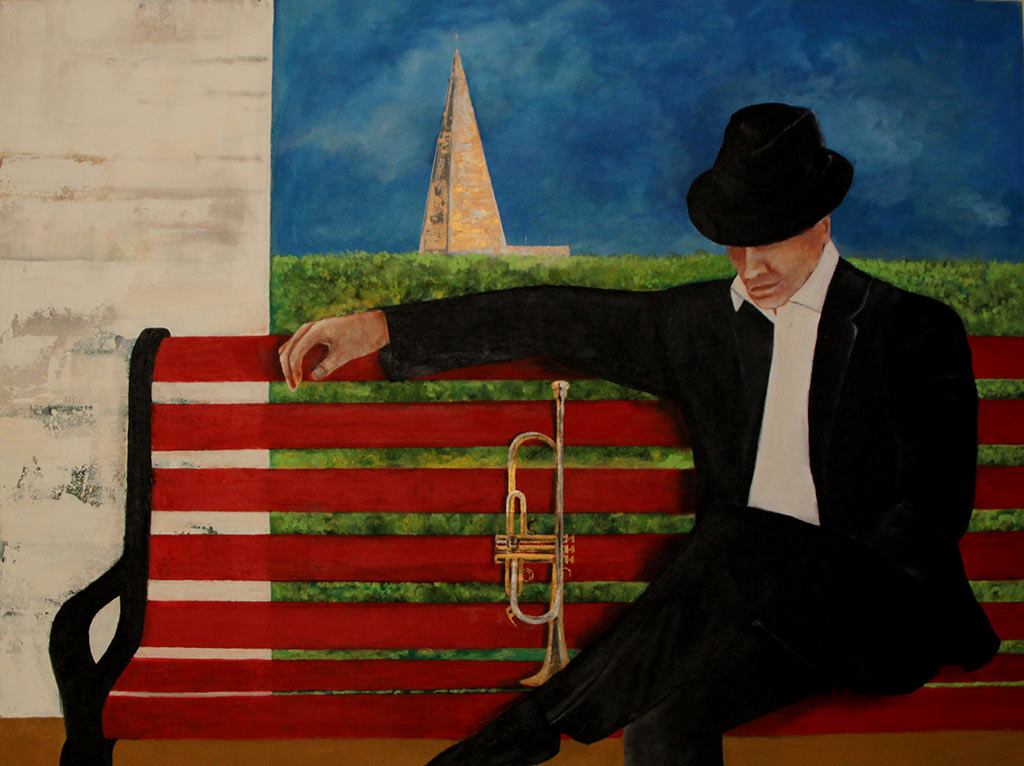Short shorts
Music from the same place

‘I travel to know the geography of myself.’ – Journal entry of a madman, quoted by Marcel Reja in L’art chez les fous (Paris, 1907)
If you look at all the buskers, it adds up to make the face of one busker. Esteban was one of them. Or, was he that one single busker standing on the pavement from dawn to dusk waiting for the coins to drop like stars from the sky? The fact is that they begin looking the same. Only the instruments they play are different. They are the same wayfarers trying to draw a map of their imaginary lives. And they all begin looking the same because they all have lines on their faces around their eyes that with time conjoin to became bags under them and expand into
the emptiness within them. A yellow emptiness like in the circle of light formed by the street lamp Esteban stood under at night, still playing his saxophone. Every day it would be a different lamppost on the same street. Sometimes, he went from end to end on either side of the busy street. Sometimes, his choices would be diagonally opposite each other. He was alone with his sax, had no family, no friends and, therefore, no enemies. He had chosen a life with his music because he clearly believed those near you, friends or family, are the ones who end up hurting you the most and not your enemies. Now, he has become such a familiar face on the street that people have begun accepting him as part of the street’s edifices. And if he were to trace his path from the time he started playing his unobtrusive tunes on the street, it would be a cartographer’s nightmare because the contours formed between the crisscross lines on the imaginary map would only reveal that Esteban had already lost the inevitable argument with time.
A harp affair

The wind could not blow Payton’s brown hair across her back as the muffler around her neck tightly bound it. Perhaps, she needed that physical tightness to keep her mind from flowing with the music. She was not playing for money. She was celebrating the resurrection of her marriage by plucking at the strings. The sound from the harp were like new waves on the white sand that had, like the others, failed in their climb. When she first met Peter he struck her as someone who seemed like a safe haven, like a bus coming by on a desert trail. He said he would like to know how the fingers that fondled the strings of a harp would feel on his skin.
And that was the beginning of the end of her 11-year-old marriage with Herman. Nearly. She had met him at a party and the first things she noticed were his eyes and lips. And she immediately asked him if he could come and change the logo of her parlour. And Herman realised it did not need any change.
They hit it off and soon got married and had two children. One day, Herman brought Peter home to listen to an evening of music and Peter said, ‘Your music floats in a space between sound and silence.’
Their conversations soon went past music, way beyond when the chords began striking at the possibility of a relationship. It did not take long for Herman to realise that something was seriously wrong. Payton had begun to stay aloof and seldom played the harp at home. She looked unhappy and often suggested a separation. And they did.
As Payton’s marriage began ending, her affair too went south. She was losing her children and this man used an expression like ‘this is your problem, not mine’. That shook her up and with each string that she struck, sounds echoed in her mind that stacked up like a pillar of wrongs.
She returned and he opened the doors for her, relieved.
Hound of the Buskervilles

Technically, Christina did not belong to this street in Paris. She was from Florence but had been besotted with Paris in 2005. After working for a few months in a restaurant, she realised that she was becoming fed up with the Parisian way of life – metro/work/sleep and wanted to try something new. Once she noticed a street musician close to her place and decided to take her chance, too. She stopped waiting tables and picked up her violin, waiting for visitors instead. She began attracting more and more people and was always surrounded by a crowd. Different from her previous life when loneliness surrounded her. She lived for music, busking in Paris. She became the fiddler in black stockings and a red coat who would pop up at tourist spots in Paris. She was especially excited to play for foreigners, as they made her think about the places from where they came from. She embarked on a journey around Europe. Dublin, Berlin, Barcelona … where sometimes there would be people who would recognise her from Paris. Which made her think. And she realised that playing in Paris could bring the world to her than going around the world.
Christina discovered Montmartre, the ‘hound of the buskervilles’. She was being heard by 500 people from five different continents. Her romantic harmonies drifted to and fro, touching each person, creating a link between them.
Silent Song

On a Wednesday morning Nikolai was contemplating giving up playing the trumpet. He sat on the bench where he sat every day, planning what he would play. He had a loyal following in the city square. They were well rewarded because he had the gift of evoking amazing spaces with a smattering of notes. He always yearned to play his music in open spaces where it could test itself against the limitless instead of competing with the sounds of the street. But his self-respect did not allow him to admit his grief.
‘I like this life,’ he told his cousin Regis who had returned after taking his clarinet on a successful tour of the globe. ‘No, you don’t,’ Regis replied. ‘In fact, you loathe it and sometimes it turns your tunes into an aching melancholy.’
If you sulk so much even the trees would refuse to lend their shadows, Regis reminded him. It was with these thoughts that he got up from his seat and walked back home calling the day off. As he walked home he threw his instrument far away into the river. When he opened the door empty handed, he looked up at his portrait that a friend had drawn and gifted to him. He looked young, almost handsome; his eyes hidden behind the rim of his hat and it seemed his eyes were fixed to the painting’s lower left-hand corner, as if looking for traces of bitterness for the very aspect of life that he had nurtured meticulously. In the picture, the trumpet leaned next to him on the bench waiting for his fingers.
The stories are based on Pratap SJB Rana’s Busker at the Corner series, executed in 2016 after he was overwhelmed by the sights of buskers who performed on the streets in the cities that he has visited in Europe. Rana is lives and works in New Delhi.
Share